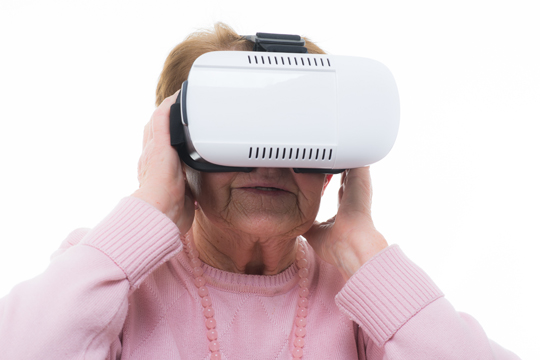Smart Goggles for Dementia Sufferers
Freiburg, Feb 13, 2019
A light to help reduce noise on intensive care wards, sensors integrated in hospital beds to prevent patients from falling, or Virtual Reality glasses that can place dementia sufferers virtually in familiar environments: there’s a large market for new technology in the health sector. But which of them actually help nursing staff and improve patient care? The Nursing Practice Center, aka Pflegepraxiszentrum für Pflegeexpertise und Technikeinsatz im Akutkrankenhaus (PPZ), at the Freiburg University Medical Center has been trialling innovations like this for a good year. The Federal government is providing it, as one of four national centers, with four million euros in funding.
 Calming and reducing agitation: Virtual Reality glasses can take dementia sufferers digitally to a familiar environment. Photo: Racle Fotodesign/stock.adobe.com
Calming and reducing agitation: Virtual Reality glasses can take dementia sufferers digitally to a familiar environment. Photo: Racle Fotodesign/stock.adobe.com
Dr. Johanna Feuchtinger has been observing the rapid developments in Health and Care on the technology market for a long time. The use of robots and Virtual Reality (VR) are even being considered in the field of care, reports Feuchtinger, who heads the quality and development in care department at the PPZ. She saw this at a trade fair in Vienna in December 2018. However, her sympathy is blended with skepticism, “While I might find humanoid robots with googly eyes really nice, a patient with dementia could feel threatened.” Assessments of how patients perceive things must be made. “A clinic is a totally alien world for an elderly person or a dementia sufferer. The environment can be fearfully stressful.” Feuchtinger sees VR spectacles, for example, as offering potential. The devices could calm a patient with a choice of pictures – for instance, by putting on the spectacles they are borne away on a virtual tram ride from Littenweiler to Mooswald, a familiar setting.
Over its five-year term, the PPZ will be testing a variety of technologies. These include bed sensors which display on-screen the movements of bed patients at risk of falling. This can keep carers informed so that they can intervene promptly. Technical aids will also be used for dementia sufferers who lose their way, get lost and in the worst case can walk on the roads endangering themselves and others. Another key area is reducing the level of noise on intensive care wards. The center wants the results to contribute to the training of nurses and caregivers; continuing professional development would also pass on the learning. In addition, an exchange of knowledge with PPZ’s three cooperation partners is planned – the Freiburg University Medical Center, Furtwangen University and FIVE, the Forschungs- und Innovationsverbund at Freiburg Protestant University of Applied Sciences.
Bed sensors display on-screen the movements of bed patients at risk of falling. This can keep carers informed so that they can intervene promptly.
Photo: Pflegepraxiszentrum Freiburg
Use on the Intensive Care Ward
The PPZ is currently trialling the use of bed sensors in care, by testing the technology for six months on two intensive care wards with more than one thousand patients. The data should be available by June 2019. The cooperation of nursing staff is high, says Feuchtinger. The information nurses and caregivers obtain about patients’ movements help them to support them individually. However, at 7,000 euros each the devices are relatively expensive. Thirteen devices are planned to begin with. The development for the ‘calm intensive care ward’ is extremely promising: a “traffic light” that displays green, amber and red shows the exposure to noise. The aim is to reduce noise levels to prevent stress to patients and also to staff. “One nurse achieved very good results on his intensive care ward. Next year we want to try out the ‘calm intensive care ward’ on other wards,” says Feuchtinger.
 A “traffic light” could help reduce the noise level on an intensive care ward – and so reduce stress for patients and nursing staff. Photo: Chaikom/stock.adobe.com
A “traffic light” could help reduce the noise level on an intensive care ward – and so reduce stress for patients and nursing staff. Photo: Chaikom/stock.adobe.com
Thinking in Algorithms
For now, there are no plans for robots, but there will be. The Viennese trade fair showed Feuchtinger the enormous potential in this field. At the same time, use of robots in care needs an overall plan, “Simply deploying a robot and leaving it alone with Mrs Meier or Müller – it won’t work like that. There is still a need for competent staff in attendance.” Technology could result in savings on personnel, but in many cases it is demanding and costly. “When using technology, caregivers need to learn to think in algorithms: if a patient is in situation X, then technology Y works – or doesn’t.” Feuchtinger shortly wants to invite some providers to Freiburg to learn about possible applications.
Do patients accept things like bed sensors? Johanna Feuchtinger says there are evasive tendencies: for example, some patients ignored sensor mats which offer them a place to stand on as they get out of bed. “This is an indication that the technology can be seen as interference,” explains Feuchtinger. Therefore it is important not to restrict patients’ autonomy. And it is equally important to involve all stakeholders – not only nurses and caregivers but also, for example, doctors, physiotherapists and assistants – in the decision-making process and in this way to ensure that findings and experiences are shared.
Hans-Dieter Fronz
Freiburg Nursing Practice Center

